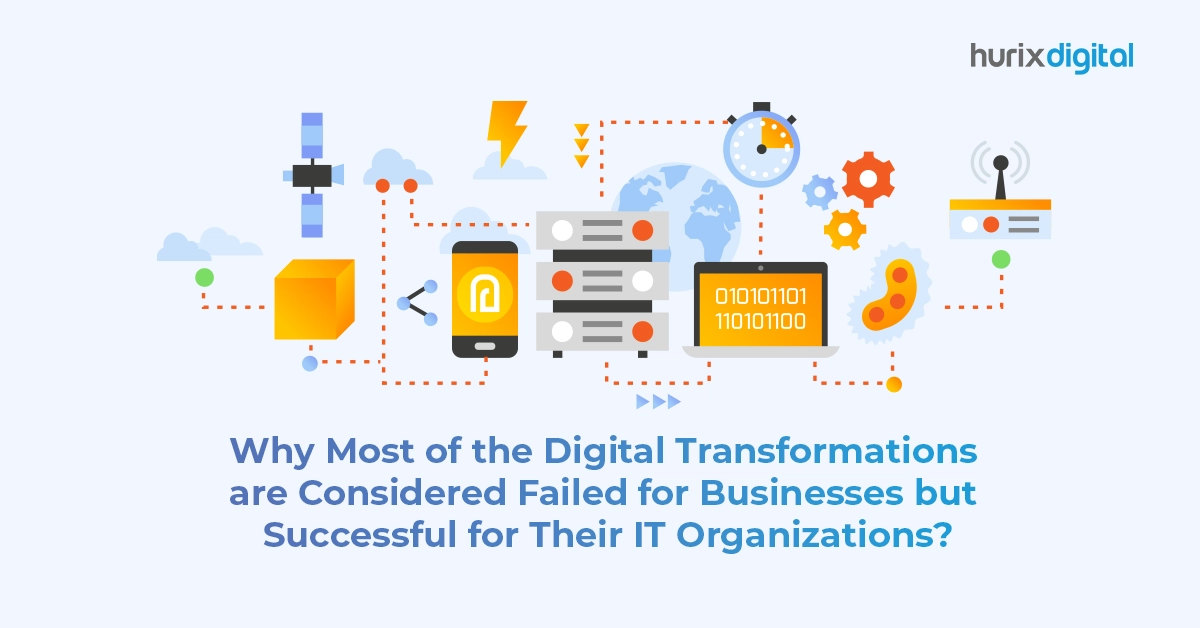
Why Most of the Digital Transformations are Considered Failed for Businesses but Successful for Their IT Organizations?
Summary
Uncover why most digital transformations fail and learn vital strategies to ensure your company’s successful evolution into a digital butterfly.
For the last more than a decade “Digital Transformation” has become an imperative for the success of any business. Businesses across industries are strategizing and executing digital transformation programs to remodel their way of doing business. But for the success of the business, the digital transformation must be strategized considering all the aspects of the business organization otherwise the outcome will be just a set of new, modified, or modernized technology stacks; not the ones that were expected by the business-like revenue growth, shorter revenue cycle, increased customer satisfaction, etc.
According to many business analysts’ recent studies around 70% of digital transformation initiatives are considered to be successful by the IT organizations but they fail to deliver the expected business outcomes. Such a kind of digital transformation scenario resonates with the statement made by George Westerman. George Westerman is a Principal Research Scientist on the digital economy at MIT Sloan School of Management and a few years back.
He said, “When digital transformation is done right, it’s like a caterpillar turning into a butterfly, but when done wrong, all you have is a really fast caterpillar”.
So, most of the digital transformations are making businesses fast caterpillars rather than transforming them into butterflies. However, there are businesses becoming butterflies out of caterpillars post-completion of their digital transformation programs.
This blog discusses the main reasons that cause a digital transformation initiative to fail from a business perspective but be successful from a technology perspective.
Table of Contents:
- Lack of Multidisciplinary Digital Transformation Strategy Team
- Compromise on Data-Driven Decisions
- Inclined more towards Customer Facing Systems and less towards Backend Systems
- “One and Done “Execution Approach
- Change Resisting Culture
- Conclusion
Lack of Multidisciplinary Digital Transformation Strategy Team
Digital transformation is not only the transformation of information technology systems in a business organization, but it is the transformation of the way of doing business. That means it is supposed to transform all aspects of a business marketing, sales, production, operations, delivery, finance, customer care, etc. So, the digital transformation strategy team must have representation from each function of the business organization so that the team can have a holistic understanding of the current state of the business along with challenges and envision the future state of the business utilizing the power of digital technologies.
The multidisciplinary digital transformation team should first define a customer journey across the business organization in the current scenario. The journey must cover every step a customer takes right from showing interest in a particular product or service to getting billed for the same or walking out somewhere in between the journey.
It should also include steps taken by customers in case of post-sales customer care requirements. Once such a customer journey map is ready then the multidisciplinary team should introspect the challenges at every step of the customer journey and envision the ways of transformation using digital technologies to define a consolidated digital transformation strategy. If digital transformation is strategized in this way, then only it will give business expected outcomes on top of the technological outcomes. However, if such a team is not built then the digital transformation will be causing technological advancement as an outcome; not the business outcome.
Also Read: The Revolution of AI in Cloud Computing: Transforming Education and Work
Compromise on Data-Driven Decisions
While strategizing the digital transformation journey, all decisions must be data-driven. The multidisciplinary strategy team should ensure data from their individual function, and they should analyze the same in an integrated manner keeping a customer journey in mind. Nothing should be assumed to define the strategy, and everything must be concluded based on data-driven decisions.
A lack of data-driven decisions in the strategy formulation of any digital transformation initiative will lead to the creation of a strategy that will be far away from reality. So, such a strategy will generate business outcomes that will not meet the expected needs of the customers an individual business function, or the overall business organization.
Inclined more towards Customer Facing Systems and less towards Backend Systems
While planning a digital transformation, people are usually more inclined towards the transformation of the customer-facing systems like websites, CRM, omnichannel customer accessibility, etc. and they are less inclined towards their backend systems like order processing, billing, finance, etc. Such inclination causes the transformation of one side of the technology stack of the business organization, but the other side remains legacy IT infrastructure and services based. That’s why as long as a customer journey is dependent on the external systems (customer-facing systems), it remains frictionless and full of good experiences.
But the moment it gets dependent on internal back-end systems, it starts getting halted. This way despite the completion of digital transformation, the business does not get the business expected outcomes. So, the digital transformation initiative must be focused on transforming internal (backend) as well as external customer-facing systems to ensure the delivery of real business outcomes post-completion of the digital transformation.
“One and Done Execution” Approach
We are living in a very dynamic era where things are changing very fast. New technologies are coming up very often in all domains be it information technology, telecommunication, health care, transportation, etc. and all these new technologies are giving birth to new possibilities in all the businesses where these technologies can be applied to build a new product or to generate a new service offering. So, any digital transformation program should not be executed with a “one and done” approach because this execution approach will mark the digital transformation program as a destination that arrived right after its completion.
But digital transformation is a journey, not a destination so it should always be going on continuously by tapping the stated and unstated needs of customers, internal users, stakeholders, etc., and meeting their needs through continuous digital transformation.
However, if digital transformation is done with a “one and done” approach then right after a year, the system or services built will lose their essence and will be unable to meet end user’s needs.
Change Resisting Culture
As stated at the beginning of this blog, digital transformation is not only the transformation of IT technology stacks instead it is the transformation of the way of doing business. So, whenever a digital transformation initiative is triggered, it proposes a new way of doing things a new product or service a new business model, etc.
That is why organizations that have been successful in their business for more than half a century using their legacy products and services and following their traditional way of doing business, resist any digital transformation initiative. Their resistance comes from the confidence built on more than 50 years of their success. They think what brought them here from there, will be taking them there from here even in the era of a dynamic digital economy.
Whenever any digital transformation initiative is started in such a business organization, most of their stakeholders resist it and do not extend their support at the required level. As a result, the digital transformation initiative fails to deliver the expected business outcomes.
Check out Success Story: Hurix Digital Modernizes IT Systems for a Food Manufacturing Giant
Conclusion
To make any digital transformation program successful first businesses will have to firmly believe that digital transformation is not only the transformation of the IT technology stacks but also the transformation of the way of doing business.
When businesses have this mindset even before thinking of any digital transformation initiative in their organizations, they will strategize, plan, and execute the digital transformation program bypassing all the above reasons.
Hurix Digital helps organizations achieve their true potential, and aid your business growth. Book a quick call to discuss your needs!

Vice President and Strategic Business Unit Head – Cloud Services
A top technology management voice on LinkedIn with 20 Years of experience in Information Technology, Cloud Services, Digital Transformation, Application Modernisation, Managed Services, IT Security Engineering and Operations Management. An avid technology Leader, Leadership Speaker, Author & Coach.







